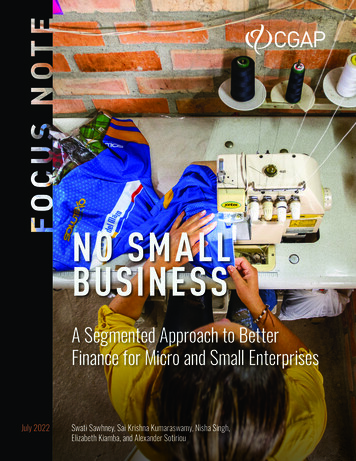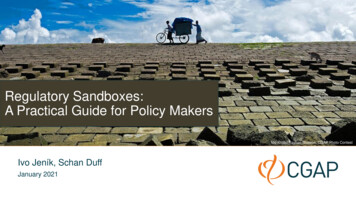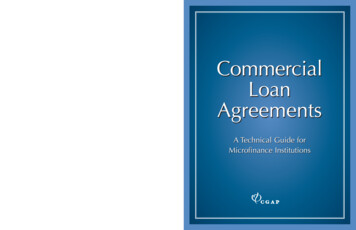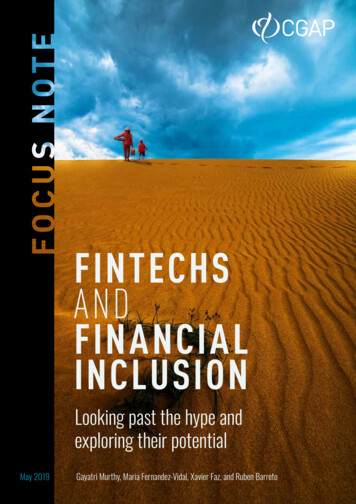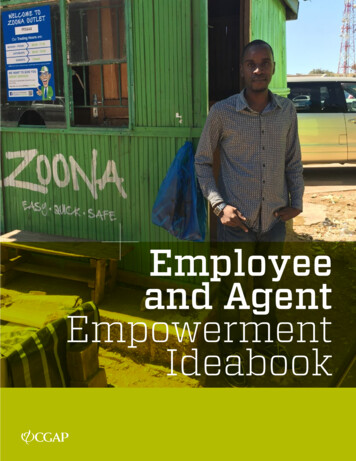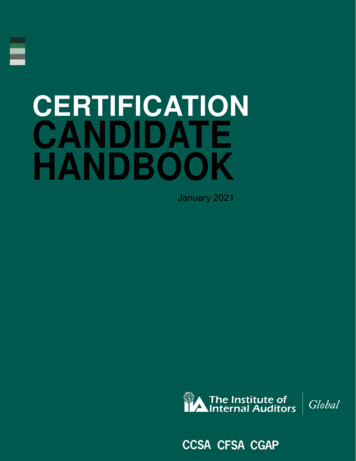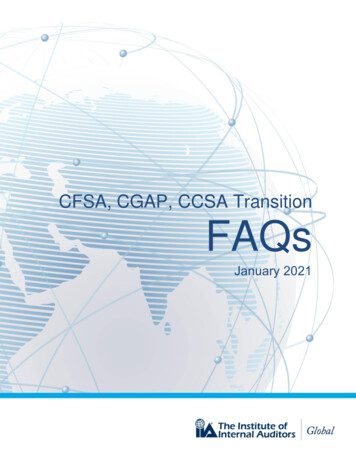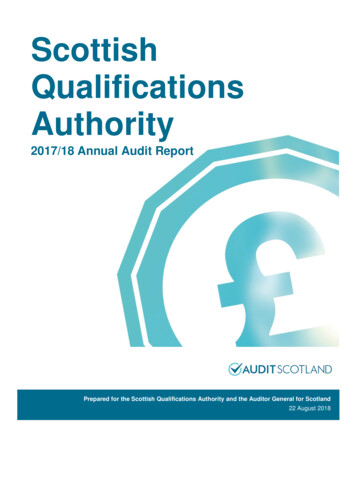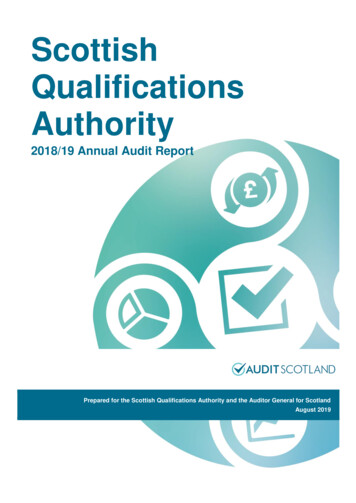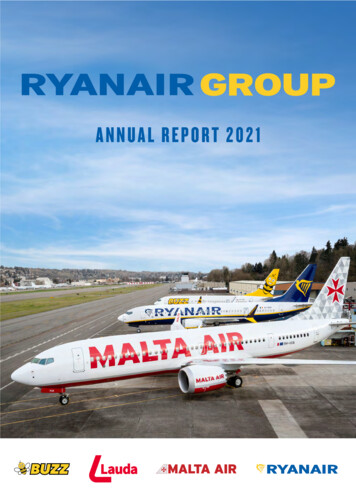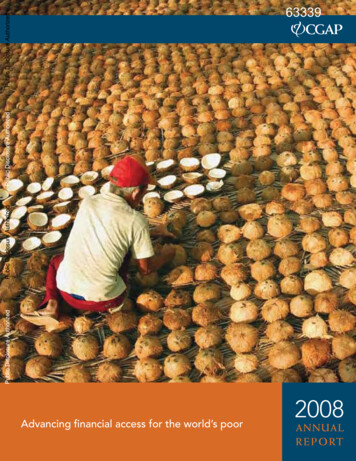
Transcription
Public Disclosure AuthorizedPublic Disclosure AuthorizedPublic Disclosure AuthorizedPublic Disclosure Authorized63339Advancing financial access for the world’s poor2008ANNUALR E P O RT
CGAP Annual Report 2008TABLE OFCONTENTS2Dear Friends and Colleagues4Access to Finance5CGAP: Who We Are5Our Vision6CGAP 2008 Highlights8Current State of Microfinance10Remaining Challenges, Gaps, and Constraints11Evaluating CGAP’s Role13CGAP Strategy14About This Report15Building Financial Market Infrastructure19Developing Diverse Pro-Poor Financial Services23Fostering Supportive Policy Environments27Improving the Effectiveness of Microfinance Funding34Communications and Publications36Monitoring and Evaluation38Governance Structure39Member Donors 200854Financial Statements1
2CGAP Annual Report 2008DEAR FRIENDSAND COLLEAGUESAmid the terrible food crisis and dramatically changingenvironments in developing countries, CGAP’s focusremains steady—advancing poor people’s accessto financial services that can help them insulatetheir families from hard times, take advantage ofopportunities, and make choices in charting their owncourse out of poverty.To do this, CGAP works to build a financial marketinfrastructure (with a particular emphasis on aspects liketechnology and financial reporting) that will support athriving market of financial services for poor people.We work with financial service providers to help themreduce costs, improve services, and grow. We workwith governments in developing countries to developpolicies that will promote access to finance whileprotecting depositors. And we work with investorsand donors to help ensure that their investments andfinancial aid in support of access to finance have thebest impact possible.This past year, CGAP has had significant breakthroughsin each of these areas. With each breakthrough, newchallenges and questions are revealed. Our workin new delivery technologies has demonstrated theviability of mobile banking (branchless banking) toreach vastly more poor customers than could bereached through brick-and-mortar branch networks.Through our nine new pilots programs in Kenya,Mongolia, the Philippines, and elsewhere, we havetested new business models and researched customerneeds. Through 10 research papers and extensive Weband workshop dissemination, we have learned andshared new knowledge about what’s needed on thebusiness end, and how local shops and kiosks can actas branchless banking agents. New challenges nowface us as we explore product and service designs thatare geared to the needs of poor clients, hindrancesto customer adoption, and adaptation needed to thebusiness model.This exciting convergence of telecommunications,banking, and payment systems is drawing the attentionof regulators in developing countries as they see thetremendous opportunity to dramatically expand theircitizens’ access to financial services by deployingtechnology. Much of CGAP’s policy work over the pastyear has focused on exploring regulatory responses tothe options created by branchless banking. This year,CGAP worked with policy makers and regulators in over20 countries to help reengineer policies and regulationsto capitalize on opportunities, while protecting poorclients.Reaching the very poorest clients remains a challenge,and a priority, for CGAP. This year, our work on“graduation” programs has gained real momentum.These programs offer a carefully sequencedcombination of grants and financial services to helpmove clients from extreme poverty to a position wherethey can save and, ultimately, graduate to make use ofa full range of financial services. With five pilots now inoperation in Asia and Latin America, we are planningseveral more in Africa. Rigorous impact studies areunderway to assess results in different contexts so wecan refine the methodology as more programs come onstream.We’ve also been bringing our expertise in technologyand branchless banking to bear to make welfare andother government-to-people payments and cashtransfers more efficient, with less leakage and betterresults in the long term. We see great potential toextend this work further to harness existing channelsfor the benefit of poor clients, and to ensure that socialpayments to the poor result in recipients’ ongoingaccess and usage of the financial system.
CGAP Annual Report 2008Another breakthrough this past year was the coalescingof support for standards of pricing transparency andcustomer protection. CGAP was proud to be able towork with 38 investors to endorse the Client ProtectionPrinciples. We firmly believe that what distinguishesmicrofinance must be the value it places on how clientsbenefit from its service. We are delighted to see suchmomentum today around these issues.CGAP’s other important work with donors and investorsthis year focuses on transparency: CGAP completed thepilot round of the SmartAid Index, with seven fundersrepresenting one-third of all cross-border funding formicrofinance. SmartAid measures how well agencies areset up to support access to finance. We also unveiled abenchmarking report on the performance of investmentvehicles in microfinance, along with the long awaiteddisclosure guidelines for these funds.CGAP’s membership grew this year, with the importantaddition of the MasterCard Foundation and CitigroupFoundation. We are deeply grateful to all of ourmembers and many partners throughout the world forall the work we do together. It is you, our members,microfinance institutions, banks, investors, policymakers, and networks that make our work possible.We thank you all for your trust, your support, and yourguidance.Sincerely,Elizabeth L. LittlefieldCEO3
4CGAP Annual Report 2008ACCESS to FINANCENearly 3 billion poor people in developing countrieslack access to the basic financial services needed tohelp them manage their precarious lives.Access to financial services—whether in the form ofsavings, credit, money transfers, or insurance—is afundamental tool for improving a family’s wellbeing and productive capacity. It empowers the poorby reducing their vulnerability, and offering themopportunities to improve their lives.When poor people have access to financial services,they invest in assets such as sending their childrento school, buying medicines and more nutritiousfood, fixing a leaky roof, or building income-earningpotential by investing in their own enterprises.
CGAP Annual Report 2008CGAP: WHO WE ARECGAP is an independent research and policyorganization dedicated to expanding access tofinance for poor people around the world. It ishoused in the World Bank and supported by over 30development agencies and private foundations thatshare our mission of alleviating poverty by advancingaccess to financial services.We work with the financial industry, governments,donors and investors, and a network of worldwidepartners to help microfinance more effectively servethe needs of poor people.We offer a range of research and advisory services tospur the growth and development of microfinance:(1) standards and good practices; (2) global marketintelligence, data, and analytics; and (3) innovativebusiness solutions.OUR VISIONCGAP works toward a world in which poor people areconsidered valued clients of their country’s financialsystem. We aim to help build efficient and equitablelocal financial markets that serve all poor people withconvenient and affordable financial services.5
6CGAP Annual Report 2008CGAP 2008HIGHLIGHTSThree new projects were approved as part of CGAP’sTechnology Program: a project with Nationbank inthe Philippines to connect at least 12 microfinanceinstitutions (MFIs) to national automatic teller machineand point-of-sale networks; a project in Ecuador todevelop a shared technology platform for 100 MFIstargeting 750,000 client accounts; and a 2 millionproject in Andhra Pradesh to enable real-time accountingfor 800,000 informal savings and credit groups and their9 million members. Over the past two years CGAP hasfunded and helped shape nine demonstration projects,targeting 15 million unbanked people.UÊ CGAP expanded its work on “graduation” pilotsaimed at creating a pathway out of poverty forchronically poor people and developed a frameworkfor client monitoring and program assessment. Theprogram carefully sequences grants, assets transfers,livelihood training, and financial services. Launchedin 2006 with the Ford Foundation, five pilots areunderway in India, Pakistan, and Haiti, and four moreare planned in Ethiopia, Honduras, Peru, and Yemen.total, more than 120 such assessments have beenapproved from 2005 to 2008.UÊ As of June 2008, CGAP was working with 13commercial banks to develop new microfinanceservices or improve existing ones. These includeEcoBank in Ghana, Syria Savings Bank, Cairo AmmanBank in Jordan, BMCE in Morocco, Forus Bank inRussia, Tameer Bank in Pakistan, Equity Bank inKenya, and Banco de Nordeste, Microinvest, andUnibanco in Brazil.UÊ CGAP provided analysis on the regulatoryenvironment for branchless banking in 10 countriesand co-authored with DFID a Focus Note for centralbankers and other regulatory authorities. In the courseof this work, CGAP consulted with more than 600central bankers, other regulators, and executivesfrom the microfinance, banking, mobile phone, andtechnology industries.UÊ The 150 organizations that make up the SocialPerformance Task Force agreed to a common set ofindicators to measure social performance of MFIs.As of June 2008, 30 MFIs were collecting informationon these indicators.UÊ CGAP provided advice on microfinance-related lawsor policy reforms in 12 countries: Cambodia, Laos,Egypt, the Democratic Republic of Congo, Kosovo,Argentina, Mexico, Syria, the Maldives, Vietnam,Madagascar, and Malawi.UÊ CGAP’s Information Systems Program, a jointCGAP–European Union program, helped finance 22MFIs in 16 countries to conduct system assessments,select and implement a new software, or improvethe reporting function of their current system. InUÊ CGAP conducted advisory work, regional policyfora, and awareness-building events on policiesaffecting access to finance in 14 countries—Brazil,Cambodia, Cameroon, Kenya, Kyrgyzstan, Rwanda,
CGAP Annual Report 2008Mexico, Russia, Nicaragua, Syria, Afghanistan,Cambodia, Madagascar, and the United Kingdom—and the Central African Economic and MonetaryCommunity (CEMAC) region, and provided trainingto 200 staff of microfinance supervisory agencies inAfrica.well funders are set up to support access to financework. These funders account for about one-third ofall cross-border funding committed to microfinance,amounting to US 4.2 billion. Results from a secondround of SmartAid will be available in FY2009.UÊ CGAP published 20 new research papers thatUÊ Created by CGAP and spun off in 2002, MIX isthe leading provider of business information anddata services for the microfinance industry. As ofJune 2008, more than 1,250 MFIs and 100 fundersreported to MIX (www.mixmarket.org).UÊ CGAP launched two key documents for investors:(1) the 2007 Microfinance Investment VehicleBenchmarking Report provided the first publiclyavailable information on the financial performanceof microfinance investment vehicles and (2) CGAP’sMicrofinance Investment Vehicle DisclosureGuidelines, developed and endorsed by 35 industryand capital market experts, provided a standardizedreporting framework to analyze microfinance fundperformance.UÊ Seven funders (ADB, CIDA, FMO, GTZ, KfW, SIDA,and UNCDF) participated in the pilot round of theSmartAid Index, a tool that provides scores on howreached approximately 100,000 people. More than200,000 individual print pieces and 5,000 CDs weredistributed. And more than 100 CGAP publicationswere translated into French, Spanish, Portuguese,Arabic, Russian, Chinese, and Bahasa.UÊ CGAP staff spoke at more than 100 industry events,either headlining or promoting new research. CGAPprovided background information for more than 600articles by mainstream, regional, and trade press.UÊ With almost 1 million visits, more than 4 millionpage views, and 50,000 monthly unique visitorsfrom 200 countries, Microfinance Gateway (www.microfinancegateway.org) is the most comprehensiveonline resource for the global microfinancecommunity. With a library of over 7,000 microfinancedocuments, Microfinance Gateway consistently ranksat the top in Google searches for microfinance.7
8CGAP Annual Report 2008CURRENT STATEOF MICROFINANCEThe microfinance industry has undergonedramatic transformations in the past five years.UÊ Microfinance has become increasinglyintegrated into the formal financial system, asmore commercial banks and retail institutions takeup microfinance as a business line. New types ofservice providers are entering the market in manycountries, including telecommunications networks,retail outlets, and credit card companies. Some arereaching very poor clients. At the same time, somecommercially oriented microfinance institutions (MFIs)are collecting deposits and tapping into domesticand international capital markets to raise financingnecessary to fuel growth.UÊ Traditional MFIs have matured and are growingrapidly. On average, half of all profitable MFIs arebreaking even within three years of start-up, muchfaster than their predecessors.UÊ More institutions are offering a broader range offinancial services, such as flexible deposit services,insurance services, and money transfers. However,microcredit continues to dominate in many countries.UÊ The need for commercial business practices hasbecome widely recognized as a precondition forsustainable provision of services. While in its earlydays microfinance was heavily subsidized by donormoney, today most microfinance clients are served byfinancially sustainable institutions that charge interestrates that cover the costs of their lending andother services. And interest rates are dropping—onaverage 2.4 percent a year.UÊ Microfinance is attracting funds from morediverse sources. In addition to major developmentfinance institutions and multilateral and bilateraldevelopment agencies, new funders are coming inquickly. Development finance institutions, the privateinvestment arm of development agencies, havestepped up their investments, with US 4.1 billionoutstanding. Private philanthropists and sociallyresponsible investors have entered the field. As of 31December 2007, 91 microfinance investment fundswere active with assets under management ofUS 5.4 billion.UÊ Microfinance is high on the agendas of manydeveloping country governments. This increasedinterest has both positive and negative implicationsfor access to finance. A wider understanding of whatit takes to build sustainable access, more helpful legaland regulatory frameworks, and a greater focus onconsumer protection and financial education are allpositive developments. However, the reintroductionof low interest rate caps and the creation ofgovernment-sponsored, direct-lending institutions, insome countries, could have negative consequencesfor the development of a robust microfinanceindustry.UÊ The business model for financial service delivery isdisaggregating as new partnerships among MFIs,banks, and more recently, telecommunicationsand credit card companies form. Such contractualarrangements frequently enable MFIs, selfhelp groups, or other agents to focus on clientrelationships, while a bank provides back-officeservices and a telecommunications company providestransaction processing.UÊ Mobile banking could become the primary bankingchannel for large segments of poor people.Branchless banking—the use of communicationstechnologies, such as cell phones and nonbankretail institutions to deliver financial services—hasdramatically reduced the cost of delivering financialservices to low-income populations in some countriesand is spreading rapidly.
CGAP Annual Report 2008The microfinance industry has undergonedramatic transformations in the past five years.UÊ The industry has become more professional, withmore and more financial service providers adheringto performance and disclosure standards developedby CGAP and others. Compliance is driven byinvestors and market expectations.UÊ The need to measure impact on poor people’slives, the poverty levels reached, and the socialperformance of institutions is gaining support. Newsocially responsible investors have joined traditionaldonors and a growing number of practitioners incalling for better measurement tools. Consensus isbuilding that client protection measures, such as clearand transparent product terms and conditions,are needed.9
10CGAP Annual Report 2008REMAINING CHALLENGES,GAPS, AND CONSTRAINTSFor all of the accomplishments—and the fresh exposure microfinance has receivedwithin the past few years—the gains are still fragile, and significant gaps andconstraints to achieving universal access to finance remain.UÊ Product diversity remains limited, especially welldesigned deposit products and transaction accountsthat could be the gateway for other services.UÊ Capacity at the management and staff level ofmicrofinance providers remains limited.UÊ Despite the increasing engagement of commercialbanks and retail institutions, real competition amongretail providers is limited. Without the pressureof competition, costs to poor clients remain high,pricing is opaque, and quality services are limited inmost markets.UÊ The local financial market infrastructure formicrofinance remains underdeveloped in mostcountries. Rudimentary payments systems and a lackof credit bureaus thwart access to finance. Shallowlocal debt and equity markets limit the ability offinancial institutions to raise capital domestically.literacy and credit histories. Expansion and adoptionof services are also held back by clients’ ownperceptions and behaviors.UÊ In many markets, subsidized government lendingprograms and poorly designed wholesale lendinginstitutions continue to undermine the developmentof sustainable financial services. The capacity ofsupervisory authorities to implement policieseffectively is often weak.UÊ Most investors seek to fund already successfulinstitutions, rather than fund riskier institutions orinvest in developing market infrastructure, which issorely needed.UÊ Despite important advances, further refinementsand incentives for measuring and reporting on socialperformance are needed. The debate around marketconduct is set to continue as the industry struggles tobalance social and financial goals effectively.UÊ Service expansion is constrained by large distancesbetween client population and lack of financialfor all of the accomplishments,the gains are still fragile
CGAP Annual Report 2008EVALUATING CGAP’S ROLEIn 2007, CGAP undertook an extensive process of industry-wide consultations with abroad range of organizations engaged in the access-to-finance arena, including MFIs,banks, microfinance networks, governments, donors, and investors. The goal was toassess the current and future needs in microfinance and to determine the role CGAPshould play in this rapidly changing environment. Key inputs to this process included aglobal survey and independent evaluation of CGAP’s performance in the past three years.Selected Findings from the Evaluation ofCGAP Phase III (2003–2008)UÊ CGAP’s training and capacity-building initiative hasThe evaluation was conducted by a team of threeindependent consultants consisting of Klaus Maurer,Sarah Forster, and Michael Mithika. The evaluationteam conferred with a broad range of stakeholders andconducted a sweeping literature review.UÊ The strong and effective communications capability isEffectivenessUÊ The CGAP operational team has made clear progressin promoting greater institutional diversity inmicrofinance. But CGAP has done little work so faron financial cooperatives and state banks, whichdeserve more attention.UÊ Work on transparency has been excellent. “CGAP canlay claim to having contributed to improved qualityand increased quantity of information available todayfrom different microfinance actors.”UÊ Attribution for policy changes is difficult to measure,but there are increasing examples in which CGAPinterventions have had a decisive effect on policymakers. CGAP is well on track to achieve expectedpolicy and legal framework outputs.UÊ Aid effectiveness is an area where CGAP has a clearmandate and an absolute advantage; it has madesome very good progress.been a great success.highly rated by all stakeholders: “CGAP publicationsand knowledge products are considered amongthe most important and influential sources in microfinance.”11
12CGAP Annual Report 2008EVALUATING CGAP’S ROLE, continuedUÊ “The CGAP operational team has produced high-qualityoutputs during Phase III. With a few exceptions, theteam is on track to produce almost all outputs.”Value for MoneyUÊ The evaluation team is confident that CGAPrepresents value for money and it compares favorablywith other organizations with similar activities andmission: “CGAP is a cost-effective and competitiveorganization.”AccountabilityUÊ Measurement of outputs is well developed, but morework is needed on tracking contribution to longerterm outcomes and objectives: “CGAP has adequategovernance and management systems that aretransparent and thorough in providing informationabout the program.”UÊ “Overall, CGAP is a powerful and pivotal force in thefield, [and it plays] a critical role in helping others tobuild inclusive financial systems. It produces highquality, high-value work that is universally respected.CGAP provides good value for money and hasearned a highly coveted brand. It has long movedfrom being a ‘program’ to being an organization ofcentral importance to helping achieve the vision of‘access for all’ in terms of financial services.”CGAP provides good value for moneyand has earned a highly coveted brand.
CGAP Annual Report 2008CGAP STRATEGYIn June 2007, CGAP’s members endorsed the strategy that will guide CGAP for thenext five years (2008–2013). This strategy was shaped by extensive industry-wideconsultations, including a scenario-building exercise that analyzed key global forcesimpacting the future of microfinance, a global client survey, an independent externalmid-term evaluation of CGAP, a virtual conference on the future of microfinance andthe role CGAP should play, and focus groups with microfinance practitioners, donors,investors, and policy makers in different regions of the world.CGAP’s overarching objective is to help build financialsystems that work for the poor, with a particularemphasis on building local, deposit-driven markets.Our focus, for at least the next five years, is to ensurethat those local financial markets are equitable—thatthey benefit poor people of all levels of poverty—andefficient—so that poor people do not pay for inefficientinstitutions and systems—and that finance for the pooris fully integrated into mainstream markets.The next phase of CGAP’s work will focus on three rolesthat emerge from our distinct comparative advantageas identified by our stakeholders:UÊ Developing standards and providing advocacy andadvisory services around those standards.UÊ Providing objective, high-quality market intelligencecomplemented by sector data and analytics.UÊ Supporting experimental new approaches, deliverychannels, and product designs.We aim to be an informed, credible, and objectiveindustry organization that is able to raise controversialissues and advocate for difficult change and reform. Weseek to stimulate and facilitate industry debate. We’reopen to all views, but we also know it is important totake well-considered, even if unpopular, positions.13
14CGAP Annual Report 2008About this ReportFinancial Market Infrastructure—Buildinga sound financial infrastructure for betteraccess to finance requires developingefficient, technology-enabled financialdelivery mechanisms that are able toprocess small transactions at low costand provide reliable information on theperformance of microfinance providers.Pro-Poor Financial Services—Developinga broad range of pro-poor financialservices is necessary because differentsegments of the poor need differentkinds of financial services. This requiresengaging a broad range of institutionsand mechanisms to deliver financialservices to poor people. Emphasis is onidentifying and learning from innovativeproducts and services that reach verypoor and unserved populations.Governments—Fostering supportivepolicy environments for microfinancemeans advising policy makers andregulators on policy issues that affectpoor people’s access to finance,developing diagnostics on policy issues,and disseminating research and guidelineson appropriate microfinance regulations.Donors and Investors—Helping donorsand investors use their resources moreeffectively entails building consensusaround and promoting good practicestandards, improving transparency onfunding flows, providing strategic advisoryservices to funders, and building donor andinvestor staff capacity.This Annual Report outlines CGAP’s workin Fiscal Year 2008 (July 2007 through June2008). This work is described according tothe key strategic areas set forth by CGAP’smembers for 2003–2008.Communications and publicationsare a cornerstone of CGAP’s role as akey knowledge center and conveningplatform for the microfinance industry.Our communications and publicationsserve to maximize the uptake andimpact of CGAP’s work.Monitoring and evaluation are themeans by which CGAP approves,monitors, and measures theperformance of both internally managedprojects and financial commitments toexternal institutions.
CGAP Annual Report 2008Building Financial Market InfrastructureAn inclusive financial system that seeks to servepoor people must be able to process smalltransactions at low cost. CGAP has invested deeplyin understanding, promoting, and improving thesefinancial market infrastructure and cost-reducingmodels over the past several years.iÜÊÌiV } iÃÊ ÊÌiV }Þ i L i ÊLÕà iÃÃÊ i ÃÊV Ì ÕiÊÌ Êi iÀ}iÊÌ ÌÊ ÛiÊÌ iÊ« Ìi Ì ÊÌ Êà } wV Ì ÞÊiÝ« Êw V ÊÃiÀÛ ViÃÊÌ Ê« ÀÊ«i « i]ÊiëiV ÞÊÌ ÃiÊ Û }Ê ÊÀi ÌiÊÀÕÀ Ê Ài Ã Ê L iÊ« iÊL }Ê Ê Ì iÀÊÌiV } iÃÊ ÀiÊ Ài ÞÊ À Ì V ÞÊÀi ÕV }ÊÌ iÊV ÃÌÃÊÌ ÌÊL ÃÊ Ê ÃÊ VÕÀÊ Ê«À Û }Êw V ÊÃiÀÛ ViÃÊÌ Ê Ü V iÊ« «Õ Ì Ã Ê7 Ì Ê ÕV Ê ÜiÀÊV ÃÌÃÊ Ê ÀiÊV Ûi i ÌÊÃiÀÛ ViÃ]ÊÜiÊÜ Õ ÊiÝ«iVÌÊv À Êw V ÊÃiÀÛ ViÃÊÌ ÊLiV iÊ ÀiÊ ÌÌÀ VÌ ÛiÊÌ Ê« ÀÊ«i « iÊÌ ÊÌ iÊ v À ÊLÕÌÊ ÀiÊV ÃÌ Þp Ê vÌi Ê iÃÃÊÃiVÕÀip «Ì ÃÊÌ iÞÊ ÛiÊÌ Þ Ê Ê i Þ ]Êv ÀÊiÝ « i]Ê- v À V ½ÃÊ *iÃ Ê L iÊÜ iÌÊÃiÀÛ Vi]ÊÜ V Ê ÜÃÊV i ÌÃÊÌ ÊÌÀ ÃviÀÊ iÞÊÕà }Ê Ê L iÊ« i]Ê ÃÊ Ê iÃÃÊV ÃÌ Þ]ÊµÕ V iÀÊÜ ÞÊÌ ÊÃi Ê iÞÊvÀ ÊÕÀL ÊÌ ÊÀÕÀ Ê Ài Ã Ê Ê ÊV Õ ÌÀÞÊÜ Ì Ê{qxÊ ÊL Ê VV Õ ÌÃ]Ê- v À V Ê ÃÊÀi} ÃÌiÀi Ê ÀiÊÌ ÊÎÊ ÊÕÃiÀÃÊ vÊ *iÃ Ê Ê ÕÃÌÊ nÊ Ì Ã Ê/ ÊÃÕVViÃÃvÕ ÞÊ «« ÞÊÌiV }ÞÊà ÕÌ ÃÊÌ Êw V Ê VViÃÃÊ Ê Ê À}iÊÃV i]Ê ÞÊÌ }ÃÊ ii ÊÌ Ê ««i \ÊÌ iÀiÊ ÕÃÌÊLiÊ Õ Ì « iÊ« Þà V ÊÀiÌ Ê VViÃÃÊ« ÌÃ]Ê Ü V ÃÌÊ ÊÌ Ài ÊÃiÀÛ ViÃ]Êà « iÊ ÊV i ÀÊ«À ÕVÌÊ ÃV ÃÕÀiÃ]Ê ÊÃ Õ Ê«À Û iÀÃ Ê Ê vÊÌ ÃÊV Êi iÀ}iÊ ÞÊÜ Ì ÊV }iÃÊ Ê ÃÌ ÌÕÌ ÊLi Û À]ÊV ÃÕ iÀÊ ÃiÌÃ]Ê Ê ÊV ÊÃiÌÊ vÊÀi}Õ Ì ÀÞÊ ««À V ià Ê- Û }ÊÌ iÃiÊ«À L i ÃÊÀiµÕ ÀiÃÊ Ê ii«ÊÕ iÀÃÌ }Ê vÊ« ÀÊVÕÃÌ iÀ½ÃÊ «Ì ÃÊ Ê«ÀiviÀi ViÃ]Ê«À Û }Ê Vi Ì ÛiÃÊv ÀÊV iÀV Ê« ÞiÀÃÊv ÀÊÀ Ã Ì }]ÊÃi Ã Ì â }ÊVi ÌÀ ÊL Ê ÕÌ À Ì iÃÊÌ Ê iÜÊÀi}Õ Ì ÀÞÊ ««À V iÃ]Ê Êw }ÊVÀi Ì ÛiÊÜ ÞÃÊv ÀÊiÛiÀÞ iÊ ÊÌ iÊÃÞÃÌi ÊÌ ÊLi iwÌÊvÀ ÊÌ iÃiÊÃiÀÛ ViÃ Ê *ÊÜ À ÃÊ Ê ÞÊ iÛi ÃÊÌ Ê iÛi «Ê ÊivwV i ÌÊw V Ê À iÌÊ vÀ ÃÌÀÕVÌÕÀiÊ ÊÌ ÊiÝ« Ê« ÀÊ«i « i½ÃÊ VViÃÃÊÌ Êw V ÊÃiÀÛ Vià Ê/ ÃÊÜ À Ê V Õ iÃÊ iÛi « }ÊÌiV }Þ L Ãi ÊLÕà iÃÃÊ i Ã]ÊÃÕV Ê ÃÊLÀ V iÃÃÊL }Ê Ê L iÊL }]ÊÌ ÌÊÀi ÕViÊÌÀ à VÌ ÊV ÃÌÃ Ê ÌÊ Ã Êi V « ÃÃiÃÊ À iÌ L Ãi Ê«À }À ÃÊÌ ÌÊi V ÕÀ }iÊÌÀ ë Ài VÞÊ ÊÌ iÊ«iÀv À ViÊ vÊ VÀ w ViÊ«À Û iÀà ÊDEVELOPING MORE EFFICIENT DELIVERYCHANNELS THROUGH NEW TECHNOLOGIES/ iÊ} Ê vÊ *½ÃÊ/iV }ÞÊ*À }À ]Ê Õ V i Ê ÊÓääÈÊÜ Ì ÊV vÕ }ÊvÀ ÊÌ iÊ Ê Ê i Ê ÌiÃÊ Õ Ì ]Ê ÃÊÌ Ê i ÃÌÀ ÌiÊÌiV }Þ L Ãi Ê i ÃÊÌ ÌÊV Ê À Ì V ÞÊiÝ« Ê« ÀÊ«i « i½ÃÊ VViÃÃÊÌ Êw V ÊÃiÀÛ Vià Ê/ ÊÌ ÃÊi ]Ê *Ê Û ÃiÃÊw V Ê ÃÌ ÌÕÌ Ã]Ê v À Ê}À ÃÃÀ ÌÃÊ À} â Ì Ã]Ê} ÛiÀ i ÌÃ]ÊÌiV }ÞÊV « iÃ]Ê ÊvÕ iÀÃÆÊV ÕVÌÃÊ À iÌÊÀiÃi ÀV Ê Ê« ÀÊ«i « i½ÃÊ «Ì Ê vÊÌiV }ÞÆÊ Ê vviÀÃÊ}À ÌÊvÕ }Êv ÀÊÌiV }Þ L Ãi Ê«À iVÌÃÊÌ ÌÊ ÛiÊ i À ÌiÀ Ê« Ìi Ì ÊÌ ÊÀ « ÞÊÃV iÊÕ«Ê VViÃÃÊÌ Êw Vi Ê"ÕÀÊ L iVÌ ÛiÃÊ ÀiÊÌ Ê Ãà Ûi ÞÊ VÀi ÃiÊ VViÃÃÊÌ Êw ViÊv ÀÊ« ÀÊ«i « iÊLÞÊ Ê i ÃÌÀ Ì }ÊÛ L iÊÌiV }ÞÊ ««À V iÃÊÌ ÌÊ ÛiÀV iÊV ÃÌÀ ÌÃÊÌ Ê« ÀÊ«i « i½ÃÊ VViÃÃÊÌ Ê« Þ i ÌÃÊÃiÀÛ ViÃÊ ]ÊÕ Ì Ìi Þ]ÊÌ Ê Ê ÊÃ Û }ÃÊÃiÀÛ ViÃÊ Ê Ó Ê Û V Ì }ÊÀi}Õ Ì ÀÞÊvÀ iÜ À ÃÊÌ ÌÊL ViÊ «« ÀÌÕ Ì iÃÊv ÀÊiÝ« i Ê VViÃÃÊÜ Ì Ê iµÕ ÌiÊ«À ÌiVÌ Êv ÀÊV ÃÕ iÀÃÊ ÊÌ iÊw V ÊÃÞÃÌi ÊDemonstration Projects/ À Õ} ÊÌÜ ÊÞi ÀÃÊ vÊÀiÃi ÀV Ê ÊiÝ«iÀ i Ì Ì ]Ê *Ê ÃÊvÕ i Ê Ê i «i Êà «iÊ iÊ i ÃÌÀ Ì Ê«À iVÌÃÊÌ À}iÌ }Ê xÊ ÊÕ L i Ê«i « i]ÊÜ À }ÊÜ Ì Ê Õ Ì « iÊ À iÌÊ VÌ ÀÃ]ÊÃÕV Ê ÃÊ Ã]ÊL Ã]Ê L iÊ15
16CGAP Annual Report 2008 iÌÜ À Ê «iÀ Ì ÀÃ]Ê Ê« Þ i ÌÊÃÞÃÌi Ê«À Û iÀà Ê/ iÊwÀÃÌÊÀ Õ Ê vÊ i ÃÌÀ Ì Ê«À iVÌÃÊ ««À Ûi Ê ÃÌÊÞi ÀÊ ÃÊLi} }ÊÌ ÊÞ i Ê iÃà ÃÊ ÌÊÌ iÊ «iÀ Ì Ê ÊLÕà iÃÃÊ i Ê iÛi Ã Ê ÊÃiV ÊÀ Õ Ê vÊÌ ÀiiÊ iÜÊ«À iVÌÃÊÜ ÃÊ ««À Ûi Ê Ê 9Óään\UÊ Ê«À iVÌÊÜ Ì Ê Ì L Ê ÊÌ iÊ* «« iÃÊÌ ÊV iVÌÊ ÌÊ i ÃÌÊ ÓÊ ÃÊÌ Ê Ì Ê ÕÌ Ì VÊÌi iÀÊ V iÃÊ / Ã Ê Ê« Ì v à iÊ *"- Ê iÌÜ À à ÊUÊ Êv ÕÀ Þi ÀÊ«À iVÌÊÜ Ì Ê,i Ê V iÀ Ê,ÕÀ Ê ÊVÕ ÀÊÌ Ê iÛi «Ê Êà Ài ÊÌiV }ÞÊ« Ìv À Êv ÀÊ ääÊ ÃÊÌ À}iÌ }ÊÇxä]äääÊV i ÌÊ VV Õ Ìà ÊUÊ Ê1-fÓÊ Ê«À iVÌÊ Ê À Ê*À ià ÊÌ Êi L iÊÀi Ì iÊ VV Õ Ì }Êv ÀÊnää]äääÊ v À ÊÃ Û }ÃÊ ÊVÀi ÌÊ}À Õ«ÃÊ ÊÌ ÊVÀi ÌiÊ Û Õ Êw V Ê«À w iÃÊv ÀÊÌ i ÀÊ Ê Ê i LiÀà 1« ÌiÃÊvÀ Ê } }Ê«À iVÌÃÊ V Õ }ÊÌ ÀiiÊÊ iÜÊ«À iVÌÃÊÃÌ ÀÌi Ê ÕÃÌÊ vÌiÀÊÌ iÊwÃV ÊÞi ÀÊi i ÊÊ ÀiÊ ÃÊv ÜÃ\ÊÊUÊ 8 V ]Ê Ê VÀ w ViÊL Ê Ê } ]Ê ÃÊV « iÌ }Ê ià } Ê vÊ ÌÃÊ L iÊL }ÊV
EcoBank in Ghana, Syria Savings Bank, Cairo Amman Bank in Jordan, BMCE in Morocco, Forus Bank in Russia, Tameer Bank in Pakistan, Equity Bank in Kenya, and Banco de Nordeste, Microinvest, and Unibanco in Brazil. UÊ. The 150 organizations that make up the Social Performance Task Force agreed to a common set of
